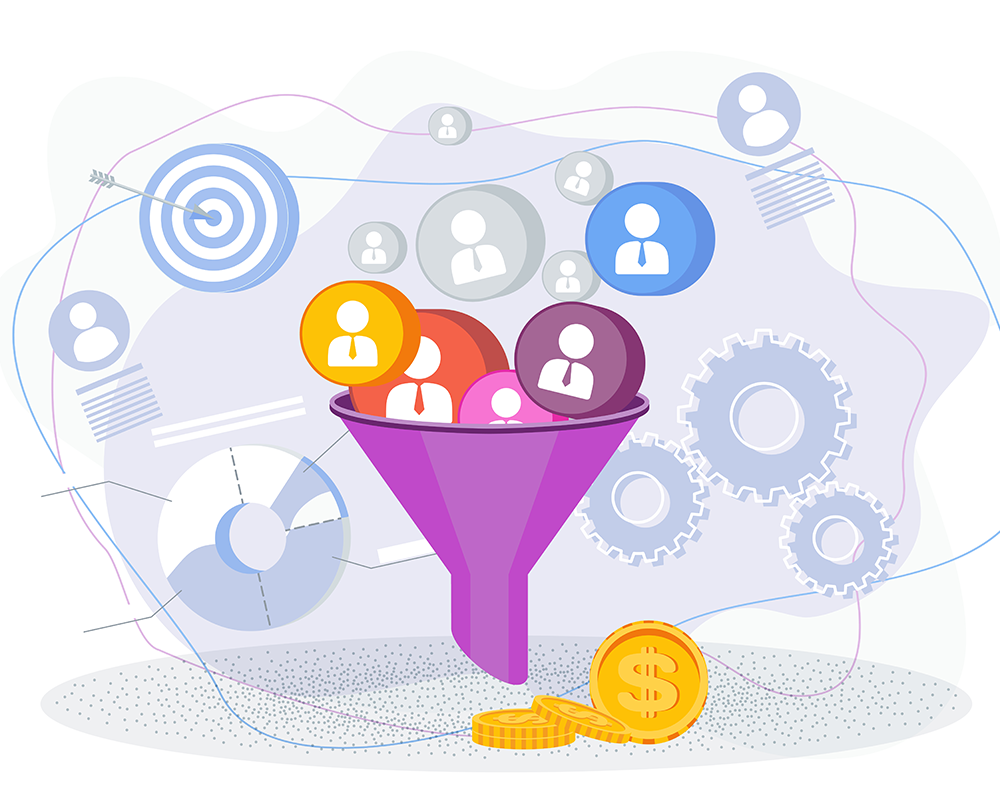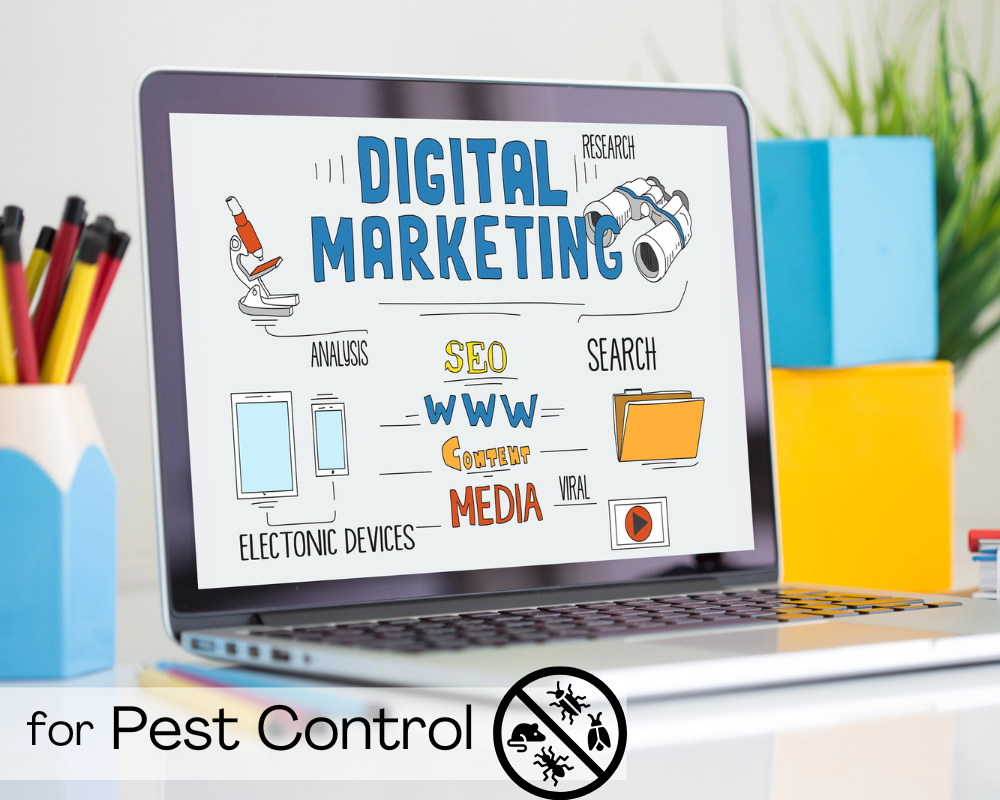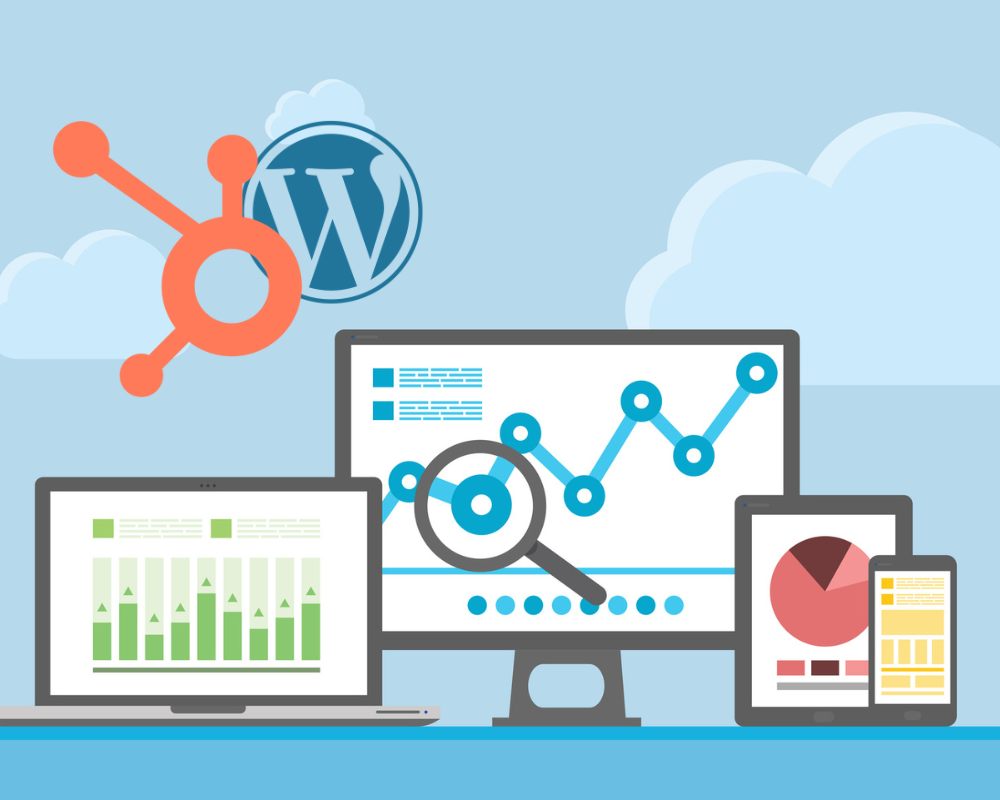How Conversion Rate Optimization (CRO) Helps Your Inbound Marketing Strategy

What is conversion rate optimization?
Conversion optimization is a term that you may be familiar with. But what does it really mean? Let's look at conversion optimization from the inside out, and see where it fits into the inbound technique, as well as how to make sure you're getting the most out of it.
Conversion optimization, also known as conversion rate optimization, is the process of putting theories to the test on different aspects of your website in order to increase the percentage of visitors that perform the desired action.
It's all about data and experimenting when it comes to conversion optimization. You may be accustomed to repurposing your material as a marketer. Repurposing might help your organization avoid duplicating efforts and uncover evergreen material. The same may be said for the look and feel of your website, as well as the user experience. Your website is an organic environment for your buyer personas to interact with your resources, not a static resource. Optimization allows you to evolve with your site's traffic as it ebbs and flows.
Conversion optimization entails more than simply statistics crunching. It's about embracing a mindset of constant growth as your buyer personas' needs evolve. It's never too late to improve your website's performance. By giving concrete statistics on how your visitors are reacting to your experiments, conversion optimization removes the guesswork from your decision-making. You can begin to collect significant insights about what your visitors prefer by using data as your feedback mechanism, rather than what you assume they should like.
Always be learning is a core principle at WorldLight Media, and that's precisely what you should be doing when it comes to conversion optimization.
Consider your website to be a giant conversion funnel for your visitors. It's all about broadening the scope and reach of each level of the funnel and making the most of the traffic that's currently there. Your website has to be a well-oiled machine that you can rely on for maximum efficiency as you scale. This involves focusing on increasing the quantity of movement from one stage to the next rather than exponentially expanding lead creation.
But how does this help your inbound marketing strategy?
Conversion optimization can be used at any level of the inbound process. "If it's worth doing, it's worth measuring," as the adage goes. It can also be optimized if it's being measured. At every point of the buyer's journey, customers interact with your website. So, whether it's an anonymous visitor or a regular customer, you should always keep an empathetic eye on your website and promotional channels keeping the user experience in mind. Limiting the optimization process to a single stage isolates the impact of the procedure.
How does conversion rate optimization affect your ROI?
Consider your sales or marketing funnel. Your funnel, at its most basic level, is made up of a set of phases that outline the different stages a visitor will go through with your organization on their route to becoming a customer. The overall shape remains the same regardless of how many steps you have or what you title them. The top is wide and the bottom is narrow.
This is because you'll see a gradual decline with each level. Not everyone will convert or continue on their way through the buyer's journey. They may not be ready to buy, or they may have found the information they needed – the reasons vary. However, having the same number of visitors begin at the top of your funnel and finish the full journey is uncommon. This has an impact on your CAC (cost to acquire a customer). Your return on investment will be lower the more resources your organization spends to acquire a customer.
If you're thinking about your company's bottom line, you have two options. You may devote more resources and effort to increasing the amount of traffic to your site, hence increasing revenue. This would increase the number of people in your funnel and, as a result, the number of people who move through it. However, in the long run, this strategy may have a detrimental influence on your client acquisition costs and return on investment. Another alternative is to boost the likelihood of current traffic converting and progressing down your funnel. This has the potential to significantly reduce your customer acquisition costs and improve your return on investment over time. So, which strategy are you going to go with?
It's crucial to remember that conversion optimization is a continuous effort. It's not a collection of quick-win strategies, so don't expect to see results right away. It entails more than merely changing the color of CTA buttons from green to red as an approach. Consider conversion optimization as a means of looking at the big picture of continuing to deliver value to your customers and incrementally enhancing it.
How to implement conversion rate optimization?
Interested in conversion rate optimization (CRO)?
Conversion optimization is an iterative and repeatable procedure, similar to the scientific method, a problem-solving strategy used by scientists to mitigate prejudice and answer issues. It consists of five steps: declare your goal, set your baseline, formulate a hypothesis, design your tests, and analyze your findings. Let's take a closer look at each of these points.
While defining your goal may appear straightforward at first, it is a crucial stage in conversion optimization. This step necessitates a three-pronged strategy. First, decide what you want to achieve. What role does this experiment play in your long- and short-term objectives? What performance measures, such as OKRs (objectives and key results) or KPIs (key performance indicators), are you trying to affect with this experiment? Conversion optimization's ultimate goal is to get the most out of your website visitors, but knowing where each of your experiments fits into the bigger picture can help you quantify your efforts to important stakeholders.
Put yourself in the position of your buyer persona. Take a fresh look at your conversion opportunities. Make a list of the issue you believe your persona is facing that has led them to your article. Make a list of anything that you believe is hurting their conversions. You may even send a survey to consumers to understand what factors influenced their decision to convert on a given opportunity. This type of information will be crucial later in the process when formulating your hypothesis.
First, narrow down the page element you wish to test. You can begin with the design of the conversion opportunity itself, such as the number of form fields or the verbs used in your buttons. Start your experiment with sections that frame the conversion opportunity, such as any supporting photos, links, headlines, testimonials, social proof, and so on. It is entirely up to you where you begin your experiments. You don't want to test different aspects of a conversion path at the same time, though. While this may appear to save time, when it comes time to examine your outcomes, it will be difficult to say which adjustment had the most impact.
Establishing your baseline is the next stage in the conversion optimization process. Take a look at how well your conversion is performing right now. Before you try to change it, try to figure out what your present data is telling you. What is your current conversion rate if you're dealing with a landing page or blog post and its form? What is the view-to-click ratio when working with a call-to-action button? Make a note of this conversion rate and store it somewhere you'll remember it.
It's time to construct a testable hypothesis after you've completed this phase in your conversion optimization procedure. "Is the traffic coming to this page the proper kind of traffic?" you might wonder. "Does someone's sight path lead them to the desired action?" "Is the page unclear, overpowering, or distracting?" you might wonder. First, sketch out the question you're trying to answer with the numbers you're viewing. Then, while outlining your objectives, consider the observations you made. Write a hypothesis statement in clear, uncomplicated language about what you believe will happen. "By implementing X modifications, the conversion rate will rise by Y since it solves Z problem," for example.
Consider the following scenario. Assume you work for a marketing agency and want to boost the number of conversions on your services enquiry page. You study the page for a while and conclude that you need to create credibility to back up some of the statements made on it. For this case, a good hypothesis would be something along the lines of: The conversion rate will increase as testimonials and photographs lend social legitimacy to our work and make us appear more genuine to cold prospects visiting our website to sign up for a consultation. This hypothesis describes the transformation you're bringing about: Increasing the number of testimonials on the page. And the issue you're attempting to solve: a lack of genuineness. Now it’s just a matter of running the tests.
Designing and performing tests is the fourth phase in the conversion optimization process. Now that you've chosen the conversion to test, it's time to implement the change you mentioned in your hypothesis. Conversions are often influenced by six factors: the offer's value proposition, the content's relevancy, the conversion path's clarity, visitor anxiety, distraction, and urgency. With those six areas in mind, you may test practically every aspect on your site that affects user behavior, from headlines to text to testimonials. Remember that you should only test one piece at a time to ensure that your data truly reflects impact.
Establish a schedule for benchmarking your experiment after you've made the adjustment. Record its performance on a regular basis and compare it to the baseline you established before. Are there any patterns that you've noticed over time? Allow at least four weeks for your test to run, depending on the number of traffic to your page. This ensures that your data is statistically significant enough to derive accurate conclusions in the majority of cases.
Finally, we'll examine your data, which will be a lot of fun. Have you noticed a significant increase in conversions on your variation page? Have you seen a decrease in bounce rate? Now is the time to see if your hypothesis and forecast were true. Examine your final data collection and compare it to the benchmarks you've been gathering all along. What are the current reporting and analytics trends? What are they trying to tell you?
If your hypothesis proves to be right, that's fantastic! You're one step closer to figuring out what works best for your website's visitors. It's fine if you don't! Use the knowledge you've gathered to create a new hypothesis. The process of conversion optimization is ongoing. You begin by identifying the factor that you believe is stopping the majority of visitors from converting and work your way through the approach to improve their experience. If you find that the conversions now coincide with your ultimate objective after examining the data, you can move on to optimizing another page or conversion opportunity. Alternatively, you might continue to explore using the same conversion path.You are not limited to just one experiment. Continue to rework sections that grab the most attention from visitors, such as headings, subheaders, and paragraphs, as this could be the key to increasing conversions in the long run. This is especially critical if you're working on portions of your website that are currently providing the highest-quality conversions. What matters most is that you are constantly learning as much as possible about your website traffic.
To summarize, conversion optimization is the process of improving your website over time in a consistent, systematic, and continuing manner. It's not simply about getting quick wins or altering the color of the buttons. It's more about delving into the psychology of why people convert or don't. Conversion optimization is the process of determining the aspects of your visitors' experience with your website you can influence and how to use the correct levers to improve it. What's the end result? A more efficient buyer's journey and inbound marketing strategy.
Why are conversions important to inbound marketing?
To summarize, a conversion occurs when a website visitor completes a desired action. This should ideally happen throughout the visitor's lifecycle. In this approach, the inbound methodology is less concerned with a visitor's specific beginning and ending points. Instead, think of inbound marketing as the process of providing value to your customers at every point of the buying process. Knowing who is gaining benefit from your resources is the goal of conversion and the data obtained at those times. Understanding who you're speaking with allows you to continue to add value to their online and purchasing experiences in a personal, helpful, and comprehensive manner.
Why is it crucial to track your conversions, aside from helping you gain information about possible leads, opportunities, and returning consumers who engage with your content? In a nutshell, the answer is data.
One of the marketing sectors you'll come across that is inextricably linked to data is conversion. This is because conversions can only be tracked if they are quantifiable. Consider conversion statistics as a means to monitor the health of your strategy over time and alert you if and when modifications are required. It enables you to ask key questions about your inbound marketing approach, including content strategy, conversation promotion, and lead nurturing efforts, such as "Is this working as expected?" Is there anything I can do to make this process better? By beginning to respond to these queries with data-driven responses, you're removing the element of guesswork from the equation. After all, numbers don't lie.
Conversions also provide you the opportunity to think outside the box when it comes to how you engage with your website users. Traditional conversion channels, such as landing pages or blog posts, can be static resources that need to be updated every now and then but still provide a one-to-many value add for your website audience.
Touchless conversion routes might be your best friend, especially if you're looking to scale your business. When done effectively, these types of conversion chances never eliminate the customization from the experience. Together with optimization methods, the proper usage of brand voice and tone on areas like forms, landing pages, blog posts, buttons, and pop-ups may assist guarantee you're still personalizing your content to speak directly to the visitor.
People's preferences for how they engage are changing as technology advances. One-to-one messaging is becoming a favored method of communication across generations, according to a recent Facebook study. Customers would rather message than phone customer service, according to 56% of respondents. This represents the beginning of a paradigm change for marketers and salespeople. How can you maintain a personalized experience while automating and driving impact in one-to-many interactions?
Experimenting with new formats and technologies, like as forms and chatbots, is a terrific approach to see what types of interactions and conversion points your buyer personas respond to best. You'll come across some procedures and conversion pathways that aren't quite right for what you're attempting to achieve. On the other hand, you might discover new ways to communicate with your website users and improve their experience.
How to build an effective conversion path
What are the steps for building an effective conversion path?
- Create awareness.
- Determine your
endpoint. - Chart your course.
- Analyze.
Conversions can be used to track the progress of your inbound marketing plan and verify that you're providing a useful, human, and comprehensive experience for your online audience. Conversion pathways are exactly what they sound like: a path. They're carefully created steps that guide your website visitor through your site, allowing them to interact with the various types of content available to them.
Creating awareness is the first step in creating a conversion route. You'll need something to draw people to your offer. This can be obvious, such as a red button or a pop-up form, or it can be discreet, such as a small chat icon in the lower right corner of your homepage. Your website visitor has come to your page for a certain reason. There's a chance they'll ask a specific inquiry. The first conversion tool you use to get their attention must demonstrate that you have the answer, or at the very least, that you can add value to their experience.
This leads us to the second step: Determine where you want to end up. A single-step conversion path is when you link to and redirect your visitors directly to a PDF using a CTA button. Often, though, your website visitor's ultimate purpose is to complete a set of steps. Where is your conversion route attempting to guide the visitor if you're developing a multi-step process? What is the most crucial activity they take? Early identification of your ultimate goal is crucial to the long-term success of your conversion path, as well as any subsequent adjustments that may be required.
If you're following the usual landing page conversion path, you're probably aiming for more people to complete the final step of filling out a form rather than just clicking the first button that drew them in. However, this will depend on the tools you have and which ones you wish to employ. Visitors could be directed to a meetings link, for example, by pressing a button. Visitors could be directed to a form via a pop-up notification. A simple chatbot could direct someone to a resource database. The options are limitless.
Charting your journey is the third phase in creating your conversion path. You've got an element that starts the conversion route and you know where you want the visitor to go. Now you must create the experience that occurs in the interim. Consider how you can build the optimal flow between your site's parts and truly tie the experience together. Don't be scared to try out different tool combinations to see what works best for your buyer profiles. While landing pages may be the ideal option for some offers, you may discover that messaging apps like live chat are also effective ways to provide content and please visitors.
This brings us to the fourth phase, which is to analyze. After the conversion, your visitor should have received a solution to their query, be on their way to enjoy your offer, or have left delighted. However, your efforts do not end there. Now is the moment to take a step back and assess how well your conversion process is working. Check in with your reports after four weeks. Does the number of visitors that convert match your expectations or goals for this particular conversion path? If that's the case, congratulations! If it isn't, consider how you might be able to experiment with and enhance the way the conversion path is set up.
Now that you've created your conversion path, how do you know you're selecting the correct conversion points to tie your conversation, promotion, lead nurturing, and content initiatives together?
Consider the following factors while creating your conversion paths:
- Value Proposition
- Relevance
- Urgency
- Clarity
- Anxiety
- Distraction
- Optimization Strategy
Let's take a closer look at each one.
Value Proposition
First, there's your offer's value proposition. If it's a content offer, you'll need to figure out what kind of content your buyer personas want. Choosing a format can be tricky, so think about your SMART goals while building your content offer. SMART goals are defined as being specific, measurable, attainable, relevant, and timely. In the short term, what do you want to achieve with this piece of content? What role do you think it will play in your long-term strategy? Alternatively, how does this material fit into the aims and stages of the buyer's journey of your visitors? Also, think about what format will deliver the best experience.
Consider the worth of the material you're creating as well as the resources required to create it. You don't want to put a lot of time and effort on a piece that doesn't fit into the overall story your firm is trying to communicate. How much time and money do you have to devote to creating this piece of content? When it's finished, how will you promote it to the rest of the world?
Building each content format will necessitate a different amount of effort and resources. It's not the same as writing a blog post or publishing an ebook to create a compelling podcast. Consider the value your visitor, lead, opportunity, or customer will receive from the conversion path or call-to-action you create for your content. This can help you figure out how much information you can fairly want in exchange for this deal.
There is an element of exchange in every transfer, even if it is not economically transactional. Contact information is the currency of marketing, and it is the currency that allows you to achieve your lead generating objectives. Consider the price you're charging for your content with this in mind. If you price it too expensive, no one will buy it. If you price it too cheap, you could not obtain the type of information you need to figure out who is converting and why. It's all about striking the right balance. You want to make sure you're providing material that encourages visitors to convert without putting any additional barriers in their way.Knowing what kind of information you'll want in exchange for a piece of content can help you figure out how to give it in the most effective way. Knowing the worth of your offer can also help you figure out how many steps your conversion route should include.
But that's just one part of the puzzle. When creating your conversion route and deciding which conversion tools to employ to convey your offer, relevance is also a factor to consider.
Relevance
Consider the following questions:
- who are you attempting to reach with this offer?
- What are you hoping to achieve?
- When should the offer expire?
- Where should it live on your site?
- Why would your personas want to participate in this offer?
- In the buyer's journey, where does this particular conversion opportunity fit?
Offering a demo with a longer form to someone who has just arrived on your site and is still in the awareness stage may not be the most beneficial. Pop-ups with content that addresses industry-level frequently asked questions, on the other hand, may not pique the interest of more qualified visitors. It all comes down to understanding what information your visitors want to view and when they want to see it.
Conversion Path Urgency
Urgency is defined as how compelled your visitor feels to do the required action in the context of conversion path creation. Buttons often utilize action-oriented terms like "download immediately," "start your trial," or "join today" to convey this sense of urgency. Putting yourself in your visitor's shoes and evaluating how you're currently framing the offer is what urgency is all about. What crucial value is lost if your visitor doesn't click the button, input their email in the pop-up, or fill out the form? Does it matter if people download today, tomorrow, or a month from now, based on the piece of content's relevance and value proposition?
Conversion Path Clarity
How well are expectations formed when a visitor looks at your conversion tool – your button, form, or live chat icon — about what will happen if they take that action? Making the transaction explicit is what clarity is all about. Use any accompanying language or graphics to describe what the offer comprises or what your visitor may expect to receive from that offer. This is especially true for landing pages.
Conversion Path Anxiety
If you're asking for an anonymous visitor's email address, that person is probably nervous. While many marketers today use the inbound tactic, there is some anxiety about who will have access to a lead's information after it is in your possession. This can be difficult to overcome, but techniques such as connecting directly to your company's privacy policy can help alleviate the tension. You want to eliminate any factors that can prompt your visitor, lead, or customer to second-guess whether or not they should complete the conversion. You want people to think, "Of course I should download this deal, this is incredible material!"
Conversion Path Distraction
Look! It's a bird, it's a plane up in the sky! Actually, it's a nuisance. Consider what might be keeping individuals from taking that step when creating an effective conversion route. In the context of landing pages, removing the navigation bar from the page is regarded a recommended practice so that visitors may focus solely on the content and conversion at hand. Similarly, too many buttons on a page or too many pop-ups throughout your site can be distracting and confusing. Consider how you may make the conversion point stand out from the rest when creating a page or adding a conversion opportunity. The precise tool you're using will dictate how you do it, but playing with features like style and position can help you motivate visitors to take action and connect with the offer.
Conversion Path Optimization Strategy
This brings us to the final point, which is optimization technique. This is the point at which you begin to adopt a more data-driven mindset. How are you going to track the performance of this offer's conversions? Will you be tracking things like form submissions, clicks, and page views? Are you intending on keeping the information relevant for long enough to run A/B tests on? If you are, make sure you're keeping track of conversions over time rather than simply at the start or end of the experiment. If not, are you basing your conversion path on any previous conversions that have worked? Having a data gathering approach will be crucial to developing your content strategy because this information will assist you in informing your audience.
Often, what you do in one area will influence what you do in another. You'll begin to construct a well-planned and effective conversion experience by using these areas as a guiding framework. By paying attention to these important areas, you can help your online audience convert in a variety of ways. Landing pages are useful, but they aren't the solution to every problem that leads to your persona visiting your site. By asking these questions, you're establishing the foundation for a varied experience that caters to your audience's tastes. You want to make sure you're providing the types of content interactions consumers desire, which may not always correspond to what's most intuitive.
As you might expect, conversion can be done in a variety of ways. Buttons, landing pages, blog articles with buttons, forms, pop-ups, live messaging, meetings links, and chatbots, to name a few, can all be found on your website. Each can be used as the appropriate tool depending on the situation. The specific combination of tools you'll need or the number of conversions you'll need is a highly contextual decision based on your goals.
The landing page conversion path is a tried and true conversion path that works well with the inbound methodology. This normally contains a catchy call-to-action button that leads to a landing page suited to your website visitor's specific needs. A well-optimized form lies above the fold and serves as a gate to the offer. After completing the form, the anonymous visitor, who is now a recognized lead, is sent to a thank you page, where they can download the offer and access the website's navigation. This strategy is commonly utilized to generate top-of-funnel leads for a range of products, ranging from ebooks to demos.
As a result, consider your website in terms of a funnel. You're only utilizing a percentage of the potential traffic by using only one sort of conversion that targets only one type of offer. If you're not getting the conversions you want from your visitors, it's time to try something new and repackage your offer. Diversifying your conversion points and investing in continual conversion optimization means that you're using data to gradually broaden your net and maximize your website traffic.







